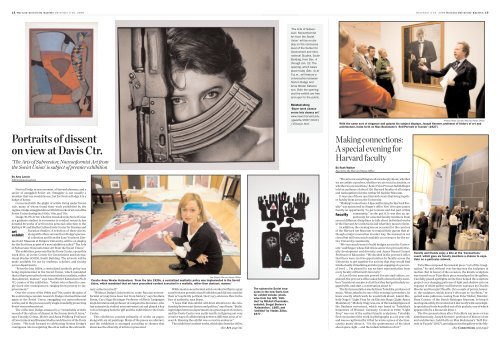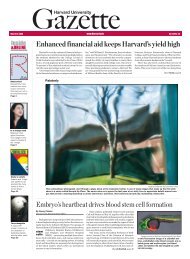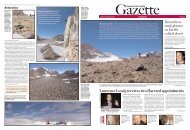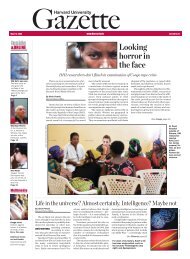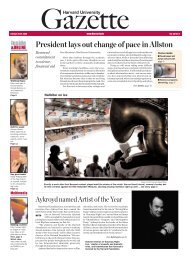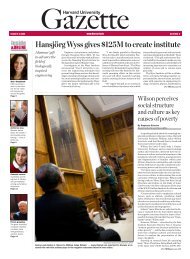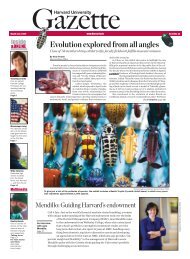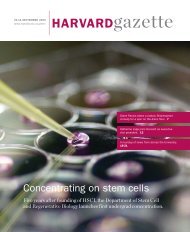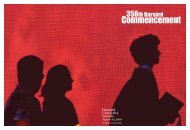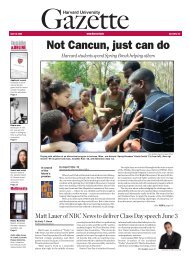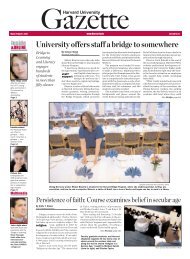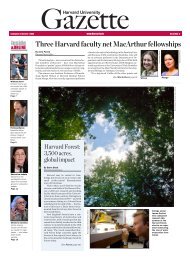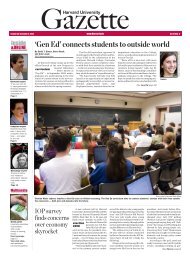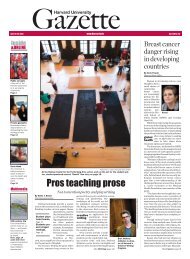Harvard University Gazette December 4-10, 2008 - Harvard News ...
Harvard University Gazette December 4-10, 2008 - Harvard News ...
Harvard University Gazette December 4-10, 2008 - Harvard News ...
Create successful ePaper yourself
Turn your PDF publications into a flip-book with our unique Google optimized e-Paper software.
18/ <strong>Harvard</strong> <strong>University</strong> <strong>Gazette</strong> <strong>December</strong> 4-<strong>10</strong>, <strong>2008</strong><br />
<strong>December</strong> 4-<strong>10</strong>, <strong>2008</strong> <strong>Harvard</strong> <strong>University</strong> <strong>Gazette</strong>/ 19<br />
‘The Arts of Subversion:<br />
Nonconformist<br />
Art from the Soviet<br />
Union’ will be on display<br />
on the concourse<br />
level of the Center for<br />
Government and International<br />
Studies, South<br />
Building, from Dec. 4<br />
through Jan. 22. The<br />
opening, which takes<br />
place today (Dec. 4) at<br />
5 p.m., will feature a<br />
conversation between<br />
Norton Dodge and<br />
Anna Wexler Katsnelson.<br />
Both the opening<br />
and the exhibit are free<br />
and open to the public.<br />
Related story,<br />
‘Boym turns chance<br />
errors into chancy art’<br />
www.news.harvard.edu<br />
/gazette/2007/03.01<br />
/15-boym.html<br />
Photos Rose Lincoln/<strong>Harvard</strong> <strong>News</strong> Office<br />
With the same sort of elegance and aplomb his subject displays, Joseph Koerner, professor of history of art and<br />
architecture, holds forth on Max Beckmann’s ‘Self-Portrait in Tuxedo’ (1927).<br />
Portraits of dissent<br />
on view at Davis Ctr.<br />
‘The Arts of Subversion: Nonconformist Art from<br />
the Soviet Union’ is subject of premier exhibition<br />
Making connections:<br />
A special evening for<br />
<strong>Harvard</strong> faculty<br />
By Ruth Walker<br />
Special to the <strong>Harvard</strong> <strong>News</strong> Office<br />
By Amy Lavoie<br />
FAS Communications<br />
Norton Dodge is an economist, a <strong>Harvard</strong> alumnus, and a<br />
savior of smuggled Soviet art. Smuggler is not usually a<br />
moniker that one would choose, but for Norton Dodge it is a<br />
badge of honor.<br />
Concerned with the plight of artists living under Soviet<br />
rule, many of whom found their work prohibited by the<br />
regime, Dodge smuggled almost 20,000 works of art out of the<br />
Soviet Union during the 1950s, ’60s, and ’70s.<br />
Dodge ’51, Ph.D. ’60, who first traveled to the Soviet Union<br />
as a graduate student in economics to conduct research, has<br />
donated 56 works of art from his personal collection to the<br />
Kathryn W. and Shelby Cullom Davis Center for Russian and<br />
art<br />
exhibit<br />
Jon Chase/<strong>Harvard</strong> <strong>News</strong> Office<br />
Curator Anna Wexler Katsnelson: ‘From the late 1920s, a centralized aesthetic policy was implemented in the Soviet<br />
Union, which mandated that art have prescribed content executed in a realistic, rather than abstract, manner.’<br />
Eurasian Studies. A selection of these pieces,<br />
along with others on loan from Dodge’s personal<br />
collection and from the Jane Voorhees Zimmerli<br />
Art Museum at Rutgers <strong>University</strong>, will be on display<br />
for the first time as part of a new exhibition called “The Arts<br />
of Subversion: Nonconformist Art from the Soviet Union.”<br />
The exhibition, presented by the Davis Center, opens this<br />
week (Dec. 4) in the Center for Government and International<br />
Studies (CGIS), South Building. The artwork will be<br />
made available for use by students, scholars, and faculty<br />
across departments.<br />
“From the late 1920s, a centralized aesthetic policy was<br />
being implemented in the Soviet Union, which mandated<br />
that art have prescribed content executed in a realistic, rather<br />
than abstract, manner,” says Anna Wexler Katsnelson Ph.D.<br />
’07, curator of the exhibition. “Artists who refused to comply<br />
faced dire consequences, ranging from poverty to imprisonment.”<br />
Over the course of the 1960s and ’70s, under the guise of<br />
his continuing economic research, Dodge returned time and<br />
again to the Soviet Union, smuggling out nonconformist<br />
works, and in the process nearly single-handedly preserving<br />
Soviet nonconformist art.<br />
The collection Dodge amassed is a “remarkable artistic<br />
record of the culture of dissent in the former Soviet Union,”<br />
says Timothy Colton, Morris and Anna Feldberg Professor<br />
of Government and Russian Studies and director of the Davis<br />
Center. “We look forward to celebrating Norton Dodge’s<br />
courageous role in acquiring the art as well as the extraordinary<br />
collection itself.”<br />
“Without Dodge’s intervention, some Russian nonconformist<br />
art may have been lost from history,” says Svetlana<br />
Boym, Curt Hugo Reisinger Professor of Slavic Languages<br />
and Literatures and professor of comparative literature, who<br />
has extensively studied nonconformist art and played a key<br />
role in bringing both the gift and the exhibition to the Davis<br />
Center.<br />
This exhibition consists primarily of works on paper,<br />
along with six oil paintings. Many of the pieces are abstract,<br />
and the exhibition is arranged according to themes that<br />
showcase the diversity of artists represented.<br />
While most nonconformist artists worked within in a gray<br />
zone between permitted and forbidden and did not consider<br />
their art explicitly political, their very existence flew in the<br />
face of authority, says Boym.<br />
“I hope that this exhibit will draw attention to the relationship<br />
between art history and politics,” says Boym. “Building<br />
bridges between departments is a great aspect of centers,<br />
and the Davis Center was really terrific in figuring out very<br />
creative ways of collaborating between different areas of research.<br />
Housing the exhibit was a creative endeavor.”<br />
The exhibition’s earliest works, which date from the 1950s,<br />
(See Art, page 34)<br />
The subversive Soviet treasures<br />
in the new Davis Center<br />
exhibit include (clockwise<br />
from top left) ‘Untitled’<br />
by Mikhail Chemiakin,<br />
undated; Sergei Borisov’s<br />
‘Kalashnikov,’ 1985; and<br />
‘Untitled’ by Vladas Zilius,<br />
1977.<br />
“The arts are something we all care deeply about, whether<br />
we are artists ourselves, whether we are social scientists, or<br />
whether we are scientists,” Senior Vice Provost Judith Singer<br />
told an audience of about 120 <strong>Harvard</strong> faculty of all stripes<br />
and ranks gathered at the Arthur M. Sackler Museum.<br />
It was one of those rare <strong>Harvard</strong> events that bring together<br />
faculty from across the <strong>University</strong>.<br />
“Making Connections: A Special Evening for <strong>Harvard</strong> Faculty”<br />
was sponsored by Singer’s office Nov. 18 to give junior<br />
faculty an opportunity “to get to know and feel part of this<br />
faculty<br />
community,” as she put it. It was also an opportunity<br />
for selected faculty members from<br />
several different disciplines to talk about individual works<br />
in the <strong>Harvard</strong> Art collections and what they mean to them.<br />
In addition, the evening was an occasion for the curators<br />
of the <strong>Harvard</strong> Art Museum to remind their guests that although<br />
a major renovation is under way, the museum is not<br />
closed but still very much available as a resource for the entire<br />
<strong>University</strong> community.<br />
“We very much want to build bridges across the <strong>University</strong>,”<br />
said Singer, whose full title is senior vice provost for faculty<br />
development and diversity and James Bryant Conant<br />
Professor of Education. “We decided in the provost’s office<br />
that there were too few opportunities for faculty across the<br />
<strong>University</strong> to get together for activity that they would find<br />
intellectually stimulating and also just engaging at a personal<br />
level. … I’m pleased to say we have representation from<br />
every faculty at <strong>Harvard</strong> <strong>University</strong>.”<br />
As Lori Gross, associate provost for arts and culture, explained,<br />
the provost’s office asked half a dozen faculty members<br />
“to pick out one piece of art that they feel particularly engaged<br />
with, and start a conversation about it.”<br />
The first presentation was by Hans Tutschku, professor of<br />
music. When asked to be one of the evening’s presenters, he<br />
knew exactly which work he would talk about: László Moholy-Nagy’s<br />
“Light Prop for an Electric Stage (Light-Space<br />
Modulator).” Moholy-Nagy was one of the leading figures of<br />
the Bauhaus movement, which was based in Tutschku’s<br />
hometown of Weimar, Germany. Created in 1930, “Light<br />
Prop” was one of the earliest kinetic sculptures. Tutschku<br />
first encountered the work in photographs as a 21-year-old,<br />
and was so captivated by it that he wrote a piece of electroacoustic<br />
music about it. “It’s the quintessence of his ideas<br />
about space, light … and the industrialization of art.”<br />
Faculty and friends enjoy a bite at the ‘Connections’<br />
event, which gave six faculty members a chance to expatiate<br />
on a particular artwork.<br />
Tutschku composed his musical piece “out of the imagination,”<br />
he said, without ever having seen the sculpture in<br />
motion. But in honor of the occasion, the kinetic sculpture<br />
was turned on as Tutschku’s piece was played in the gallery.<br />
Carefully placed spotlights on the floor helped the sculpture<br />
project ever-changing patterns of light and shadow onto an<br />
expanse of white gallery wall between canvases by Charles<br />
Sheeler and Georgia O’Keeffe. (At a couple of points, however,<br />
the sculpture, which doesn’t often get to “perform,” required<br />
some judicious coaxing from Peter Nisbet, Daimler-<br />
Benz Curator of the Busch-Reisinger Museum, to keep it<br />
moving smoothly. He worked on it discreetly with some highly<br />
specialized tools he pulled out of his pockets, one of which<br />
appeared to be a Roosevelt dime.)<br />
The five presentations after Tutschko’s ran more or less<br />
simultaneously. Joseph Koerner, professor of history of art<br />
and architecture, held forth on Max Beckmann’s “Self-Portrait<br />
in Tuxedo” (1927), just adjacent in the gallery to the Mo-<br />
(See Connections, next page)


